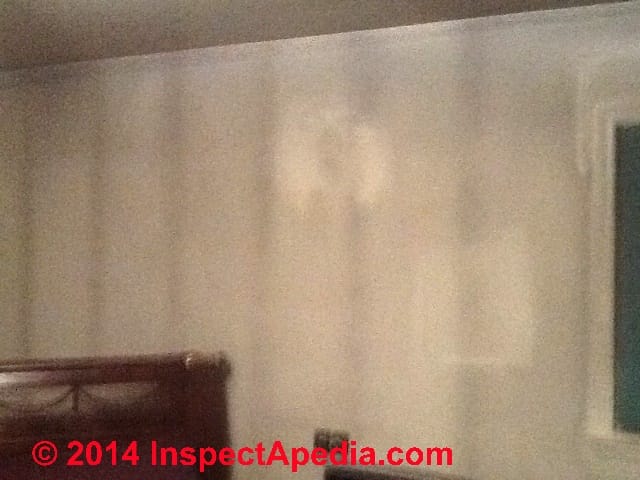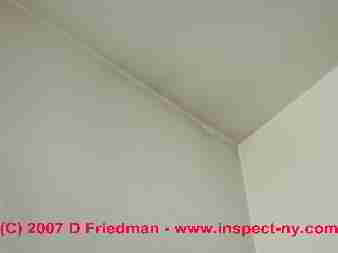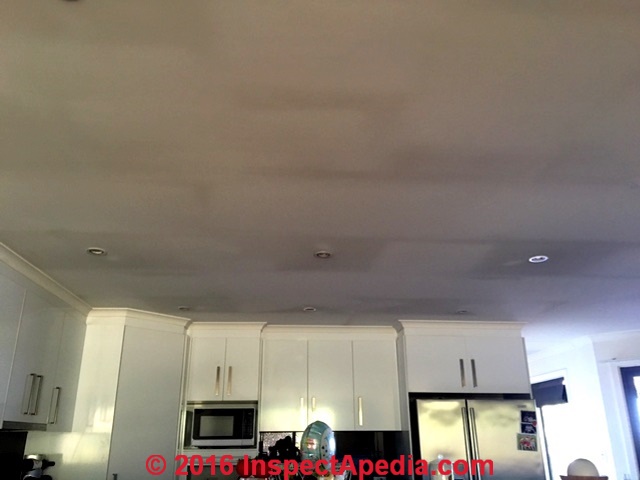 Causes of Dark Lines or Rectangular Stains on Indoor Walls or Ceilings: Ghosting Stains
Causes of Dark Lines or Rectangular Stains on Indoor Walls or Ceilings: Ghosting Stains
Building Air Leaks & Heat Loss Points show up as thermal tracking stains
- POST a QUESTION or COMMENT about indoor stains and thermal tracking or ghosting on walls and ceilings
Indoor stains appearing in streaks or dark lines or in rectangular areas in buildings traced to black or dark thermal tracking or ghosting:
What caused dark stain lines on walls or ceilings usually spaced at regular intervals, or dark rectangular stains on walls or ceilings? A combination of thermal tracking or ghosting and insulation voids may explain these indoor stains.
This article series describes & diagnoses the cause of various interior wall and ceiling stains and explains how to recognize thermal tracking, (also called ghosting or ghosting stains or thermal bridging stains), building air leaks, and building insulation defects.
Often these stains are mistaken for toxic indoor mold.
InspectAPedia tolerates no conflicts of interest. We have no relationship with advertisers, products, or services discussed at this website.
- Daniel Friedman, Publisher/Editor/Author - See WHO ARE WE?
Why does Thermal Tracking or Ghosting Often Appear in Streaks or Lines?
![]() Thermal tracking may mark the location of building framing members
Thermal tracking may mark the location of building framing members
In a conventionally-framed wood structure, wall and ceiling framing is typically spaced on 16" or 24" centers, and thermal tracking will tend to cause dust or soot to adhere to the interior surfaces at these locations because the R-value of the wall or ceiling is a bit less where the framing members are located than it is through the ceiling or wall cavity insulation.
You can see this phenomenon in our photograph of dark vertical lines along a wall in our page top photo, and just above, our ceiling stain photo shows lines corresponding to the location of ceiling joists.
Usually these parallel lines will appear on roughly 16-inch centers in a conventionally-framed building, or possibly on 24-inch centers where that framing method is used.
But thermal tracking or bridging stains may occur on different intervals depending on how the building was constructed, where air is moving, where air leaks are occurring, where there are gaps in building insulation, and wherever building surfaces are cooler or more moist.
Airborne dust particles, whether simply from normal house-dust or from a more-serious problem such as soot-producing heating equipment, sticks to the ceiling or wall surface more at those cooler, more-damp locations.
Chief Causes of Thermal Tracking Stains
- Missing insulation -
cooler areas will see more condensation of moisture on the wall or ceiling and thus will collect more airborne dust particles - Air leaks into a ceiling or wall
will often increase dust deposition around the points of air leakage - Water leaks into a ceiling or wall
or abnormally-high levels of moisture or condensation in such cavities. - Indoor soot and dust sources
including normal house dust sources - more dust sources = more rapid stain formation.
We see this in buildings where people use scented candles, fireplaces, smoke, or where an oil burner is not properly maintained and is producing soot; pets, particularly big long-haired dogs who bring dust indoors also increase ghosting stain formation.
Watch out: soot from gas or oil fired heating equipment indicates improper operation that can be very dangerous: both carbon monoxide hazards or puffback explosion hazards. - The indoor humidity level -
more humid = more rapid dust deposition - See THERMAL TRACKING REMEDIES for a detailed guide to removing and preventing future ghosting or thermal tracking stains in buildings.
Thermal Tracking Stains as Lines, Streaks, or Spots in a Line
Ghosting or thermal tracking spots in parallel lines (photos above): black wall stains in a vertical striped pattern is particularly easy to identify on walls marking stud locations.
In less extreme cases of ghosting you may just see dark spots in relatively straight parallel lines marking the locations of studs and, in the case of the photograph above, ceiling joists.
In our photo below we see both the thermal tracking lines following wall studs and small dark round dots that mark drywall nails or screws.
![]()
Those spots are the locations of drywall nail or screw heads:
see WALL THERMAL TRACKING STAINS for some interesting examples of spots at drywall fasteners.
The reason thermal tracking tends to mark the location of building framing members is because the interior wall or ceiling surface will be cooler (during the heating season) where framing members (joists or studs) are located.
However as you can see in our photo below, do not assume that all thermal ghosting stains will track framing members. Air movement is reduced close to the ceiling-wall intersection, another location of ghosting stains.
[Click to enlarge any image]
But the insulating value of wood is pretty low (about R1 per inch) compared with fiberglass insulation or other insulating materials.
These points of increased building heat loss, caused by the presence of solid ceiling joists or wall studs separating building insulation are also called points of thermal bridging - points where there is more building heat loss than through the building insulation itself.
The sections of an interior wall or ceiling which are touching wood framing (inside the ceiling or wall cavity where a ceiling joist or wall stud was placed) will conduct heat to the outdoors faster than the "in between" sections of wall where insulation has been placed.
In sum, the wall or ceiling interior surface will be cooler where the framing is located than will be the spaces which are not touched by framing and which, perhaps, are insulated.
In sum, if you see black streaks up the building wall in a regular 16" or 24" pattern, particularly on cooler exterior walls but potentially anywhere, it may be thermal tracking.
Interior stains help diagnose building conditions: Since thermal tracking, or soot marking, or "thermal bridging" as a few folks call it usually tells us something about a lack of building insulation or about air leaks in buildings, we can use these marks or stains to learn important facts about a building.
Parallel dark lines that are not thermal tracking
The dark parallel wall stains above are probably just shadows. Details about this picture are found
at STAINS MISTAKEN for GHOSTING
This photo along with more photos of actual thermal tracking that was present in this home are also discussed
at THERMAL TRACKING GHOSTING FAQs
Causes of Dark Areas, or Rectangular Stains on Ceilings or Walls
Sooty or dark smudges or stains appearing near the ceiling On the inside of building exterior walls, especially in older homes whose interiors have not been re-painted or cleaned in some time.
Thermal tracking stains may appear at the top of the wall and extend onto the ceiling surface such as shown in this photograph.
Note those dark "stripes" extending along the ceiling and into the room?
These ceiling stains probably mark the location of ceiling joists (where the in-room ceiling surface temperature was kept a bit cooler since these locations in the ceiling cavity are occupied by a wood joist rather than by insulation).
See CEILING STAIN DIAGNOSIS for details of diagnosing stain patterns on building ceilings and on cathedral ceilings.
The dark rectangular stains on the kitchen ceiling shown in this reader-contributed photograph probably mark areas of insulation voids in the ceiling in the Australian home shown above.
Additional air leakage and convection currents occurring around recessed ceiling lights (pot lights) can increase the air movement into such ceilings and thus increase staining around the lights. [Thanks to Aussie reader T.D. for contributing this photo 1/3/2016]
Question: explain these large dark rectangles on our ceiling
The ceiling below attic has huge rectangles… fan in attic runs non stop. Not damp up there. Couldn’t find anything quite like this on your site. Father’s home. Not sure of next steps. - Ray S.
Moderator reply:
@Ray S,
That thermal tracking pattern, wide dark areas in ceiling joist bays separated by lighter lines marking ceiling joist locations, is the reverse of the more common pattern (light joist bays dark joist marks) and indicates - I am guessing - poor insulation in the ceiling.
The ceiling fan's use might be a factor in how quickly these big wide dark areas show up: by moving indoor air constantly over the ceiling more airborne dust comes into contact with the ceiling surface, giving more particles a chance to stick there.
We might confirm that if you observe that these stains are less or not even noticeable at all in other rooms on the same building floor but where there is no ceiling fan.
And we'll further confirm that theory if, when you inspect the attic, you see that the insulation, probably minimal, is nevertheless uniform over all of the ceilings.
Or, less common, we might find that insulation was just missing over some ceiling areas.
Watch out: In addition to considering adding insulation (after inspecting the attic for leaks, moisture, moldy drywall on the attic side of ceilings), you'd check to be sure that the dark deposits are only normal house dust - versus something more troublesome (sooty fireplace, scented candles, pets, poor housecleaning) or more-dangerous (improperly-operating oil or gas burners).
...
...
Continue reading at THERMAL TRACKING REMEDIES or select a topic from the closely-related articles below, or see the complete ARTICLE INDEX.
Or see GHOSTING DARK STREAKS or LINES FAQs - questions & answers posted originally at this page
Or see these
Recommended Articles
- AIR MOVEMENT in BUILDINGS - When, where, how & why air moves in buildings.
- CEILING STAIN DIAGNOSIS
- MOLD APPEARANCE - STUFF THAT IS NOT MOLD
- STAINS on INDOOR SURFACES, PHOTO GUIDE
- THERMAL TRACKING BRIDGING GHOSTING - home
- DEFINITION of THERMAL TRACKING
- EIGHT INTERACTING FACTORS CAUSE GHOSTING
- AIR VELOCITY & MOVEMENT PATTERNS
- COMPOSITION of DARK GHOSTING STAIN PARTICLES
- GHOSTING STAIN INSPECTION
- GHOSTING DARK STREAKS or LINES: CAUSES
- GHOSTING DARK RECTANGULAR STAINS: CAUSES
- GHOSTING DARK STAINS from AIR LEAKS
- GHOSTING DARK STAINS on INSULATION, AIR BYPASS LEAKS
- GHOSTING STAINS on WALLS
- STAINS CANDLES FIREPLACE WOODSTOVE
- STAINS DIAGNOSE IAQ PROBLEMS
- STAINS INDICATE SAFETY CONCERNS
- STAINS MISTAKEN for GHOSTING
- THERMAL TRACKING REMEDIES
Suggested citation for this web page
GHOSTING DARK STREAKS or LINES: CAUSES at InspectApedia.com - online encyclopedia of building & environmental inspection, testing, diagnosis, repair, & problem prevention advice.
Or see this
INDEX to RELATED ARTICLES: ARTICLE INDEX to BUILDING STAINS
Or use the SEARCH BOX found below to Ask a Question or Search InspectApedia
Ask a Question or Search InspectApedia
Try the search box just below, or if you prefer, post a question or comment in the Comments box below and we will respond promptly.
Search the InspectApedia website
Note: appearance of your Comment below may be delayed: if your comment contains an image, photograph, web link, or text that looks to the software as if it might be a web link, your posting will appear after it has been approved by a moderator. Apologies for the delay.
Only one image can be added per comment but you can post as many comments, and therefore images, as you like.
You will not receive a notification when a response to your question has been posted.
Please bookmark this page to make it easy for you to check back for our response.
IF above you see "Comment Form is loading comments..." then COMMENT BOX - countable.ca / bawkbox.com IS NOT WORKING.
In any case you are welcome to send an email directly to us at InspectApedia.com at editor@inspectApedia.com
We'll reply to you directly. Please help us help you by noting, in your email, the URL of the InspectApedia page where you wanted to comment.
Citations & References
In addition to any citations in the article above, a full list is available on request.
In addition to citations & references found in this article, see the research citations given at the end of the related articles found at our suggested
CONTINUE READING or RECOMMENDED ARTICLES.
- Carson, Dunlop & Associates Ltd., 120 Carlton Street Suite 407, Toronto ON M5A 4K2. Tel: (416) 964-9415 1-800-268-7070 Email: info@carsondunlop.com. Alan Carson is a past president of ASHI, the American Society of Home Inspectors.
Thanks to Alan Carson and Bob Dunlop, for permission for InspectAPedia to use text excerpts from The HOME REFERENCE BOOK - the Encyclopedia of Homes and to use illustrations from The ILLUSTRATED HOME .
Carson Dunlop Associates provides extensive home inspection education and report writing material. In gratitude we provide links to tsome Carson Dunlop Associates products and services.




